Unit 1 It's on your head! 课件(48张PPT,含音频)
文档属性
| 名称 | Unit 1 It's on your head! 课件(48张PPT,含音频) | 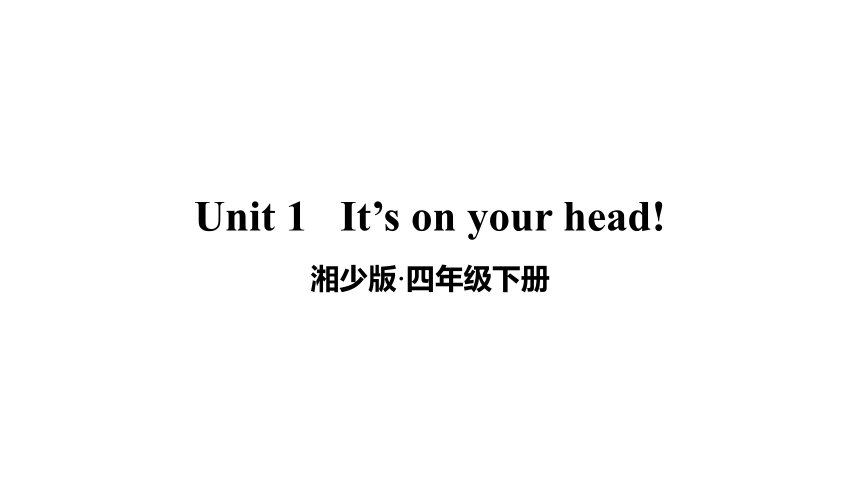 | |
| 格式 | ppt | ||
| 文件大小 | 5.4MB | ||
| 资源类型 | 教案 | ||
| 版本资源 | 湘少版 | ||
| 科目 | 英语 | ||
| 更新时间 | 2020-06-11 21:34:16 | ||
图片预览


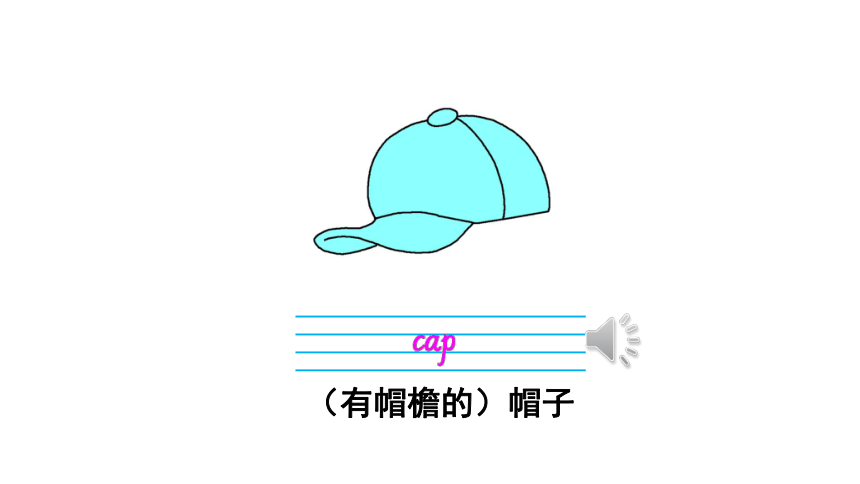
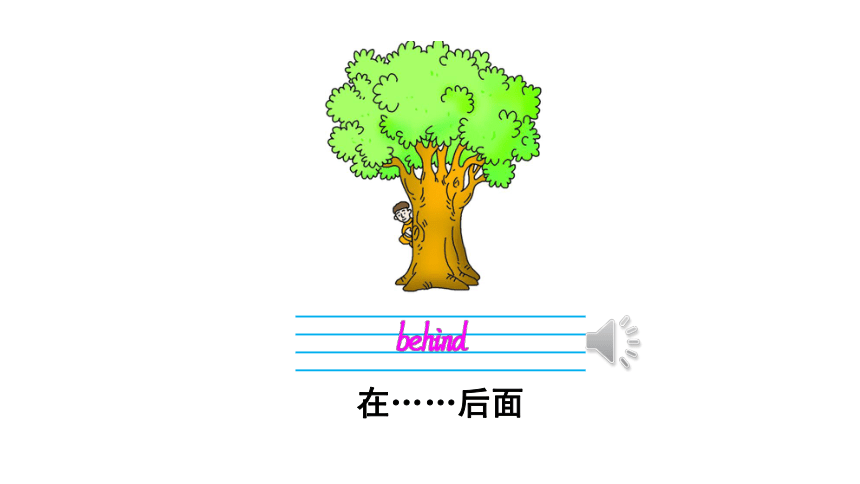


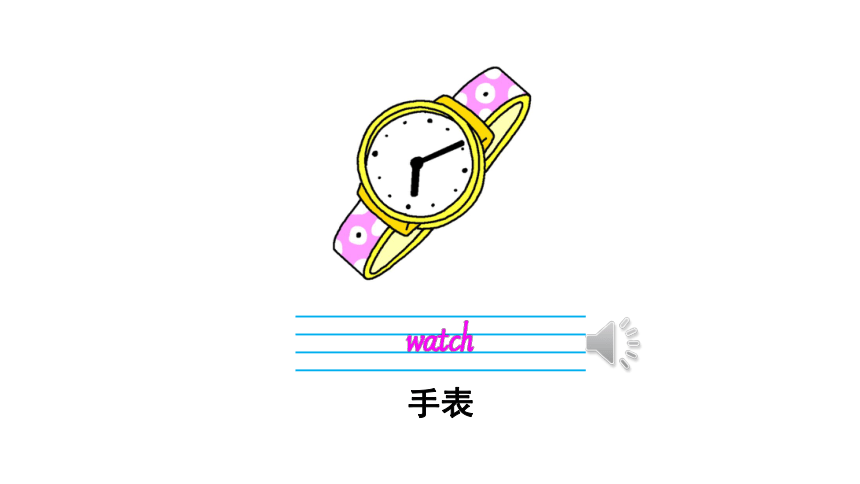

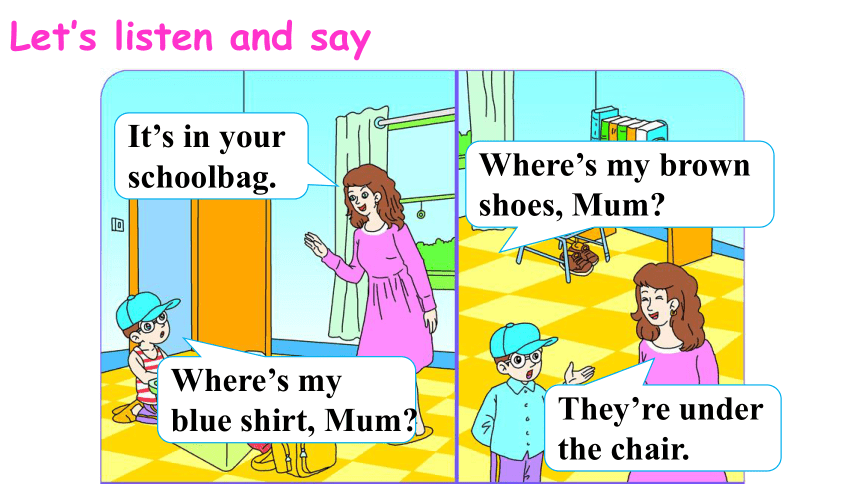
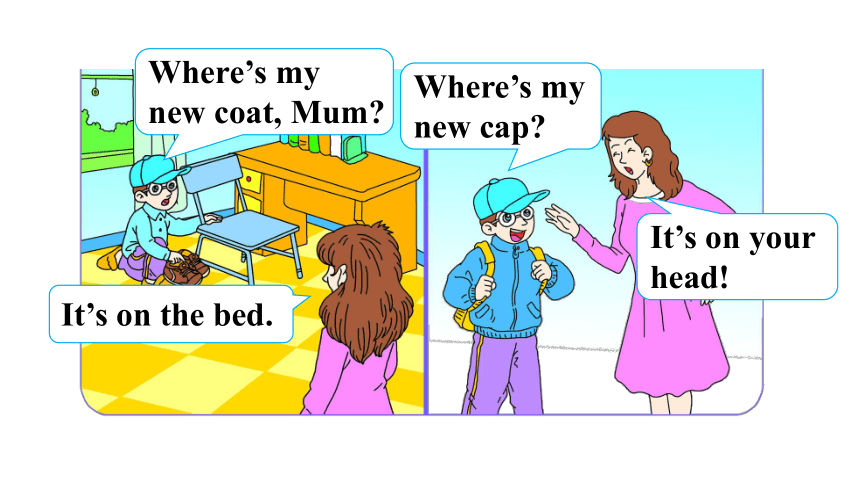
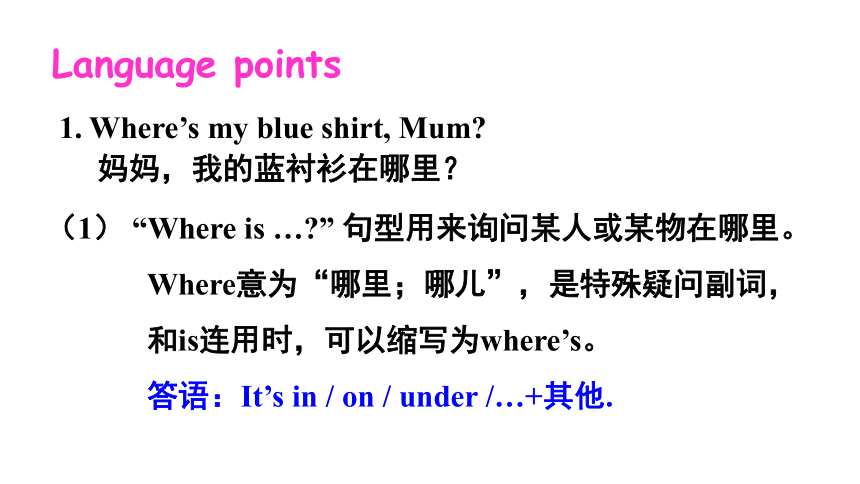

文档简介
Unit 1 It’s on your head!
湘少版·四年级下册
新的
New words
(有帽檐的)帽子
在……后面
在……旁边
在……中间
手表
眼镜
Where’s my blue shirt, Mum?
It’s in your schoolbag.
Where’s my brown shoes, Mum?
They’re under the chair.
Let’s listen and say
Where’s my new coat, Mum?
It’s on the bed.
Where’s my new cap?
It’s on your head!
Language points
1. Where’s my blue shirt, Mum?
妈妈,我的蓝衬衫在哪里?
(1) “Where is …?” 句型用来询问某人或某物在哪里。
Where意为“哪里;哪儿”,是特殊疑问副词,
和is连用时,可以缩写为where’s。
答语:It’s in / on / under /…+其他.
(2)my是形容词性物主代词,意为“我的”。
形容词性物主代词具有形容词的特征,常放在名词
前作定语,表示“某人的”。
例句:他是我哥哥。
He’s my brother.
拓展:常见的形容词性物主代词
my 我的 your 你的,你们的
our 我们的 his 他的
her 她的 its 它的
their 他/她/它们的
2. It’s in your schoolbag. 它在你的书包里。
描述某物在某处的句型:It’s in /on /under…
其中it“它”指上文中提到过的事物。
it’s是it is的缩写形式。
例句:我的包在哪里?
它在你的椅子上。
It’s on your chair.
Where is my bag?
拓展:in的用法
(1)表示场所、地点、位置,意为“在……之内,
在……中”。
例句:She lives in London. 她住在伦敦。
(2)表示时间,意为“在……期间,在……之后”。
例句:It’s hot in summer. 夏天很热。
(3)表示“在……方面,对于”。
例句:She does well in painting. 她擅长绘画。
(4)表示“穿着”。
例句:She is dressed in a red dress.
她穿着一条红色的连衣裙。
in 还可以作副词,意为“进;在家”。
例句:Please come in. 请进。
Is your father in? 你爸爸在家吗?
3. It’s on the bed. 它在床上。
这是一个陈述句,用来陈述某物在某地。
介词on的常见用法:
(1)用在具体的节日或一个特定的时间前面。
on Christmas Day 在圣诞节
on Tuesday 在周二
(2)用在某物的前面,表示位置在某物上并且跟
某物接触。
on the wall 在墙上
on the desk 在书桌上
(3)on 还可作副词,与动词连用,构成短语。
come on 加油
go on 继续
put on 穿上;戴上
behind
在……中间
beside
between
在……后面
在……旁边
Let’s learn
眼镜
cap
(有帽檐的)帽子
watch
手表
glasses
Language points
behind 在……后面
behind是方位介词。
反义短语:in front of 在……前面
例句:王叔叔站在桌子前面。
Uncle Wang stands in front of the desk.
拓展:表示在……上面的词语
例句:球在盒子上方。
The ball is above the box.
above
位置高于某人或某物,但不一定是正上方。
例句:球在盒子上。
The ball is on the box.
on
指在某物的表面上,强调两物接触。
over
例句:球在盒子的正上方。
The ball is over the box.
在某人或某物的正上方。
Let’s act
Lingling, where’s your book?
It’s under the desk.
Peter, where’s your cap?
It’s on my head.
Where’s my book?
I put it on my desk. Where is it?
Let’s read
Please stand up, Dino.
Here it is. Thank you, Dino.
You are clever.
1. Please stand up, Dino. 迪诺,请站起来。
Language points
用于表达命令、请求、劝告、警告、禁止等的句子叫祈使句。
本句是一个祈使句,以动词原形开头,省略了主语You,祈使句前面加上please表示礼貌,语气更加委婉客气。
几种常见的祈使句
Be +表语(+其他)
Don’t be +表语(+其他)
实义动词原形+其他
Don’t+实义动词原形(+其他)
Let+宾语+动词原形(+其他)
Let+宾语+not+动词原形(+其他)
Don’t let+宾语+动词原形(+其他)
Be careful!
Don’t be lazy!
Open your door!
Don’t play on the road.
Let me have a look.
Let’s not waste time.
Don’t let her go there.
2. Here it is. 它在这里。
通常以 here 或 there 开头的句子用倒装形式。
如果句子的主语是代词,则谓语动词要置于主语之后。如:Here you are.给你。
如果句子的主语是名词,则要将谓语动词置于主语之前。如:Here are your rulers.这是你的尺子。
Here they are! 它们在这儿!
Here it is! 它在这儿!
they 指复数的事物,而 it 指单数的事物。
(1)把物品递给某人,意为“给你;拿去!”。
例句:—Pass me the plates, please.
请把盘子递给我。
—Here they are! 给你!
Here they are 的含义
(2)找到了要找的东西,意为“在这儿!”。
例句:—Where is my postcard?
我的明信片在哪儿?
—Here they are! 在这儿!
Let’s read and write
Five birds fly into Mary’s room. The room is clean. They like it very much. We
can see the blue bird on the
chair. The red bird is under
the chair. The brown bird is
beside the books. The white bird and the black bird are on the desk. They are between the caps.
1. The blue bird is ________ the chair.
2. The white bird is ___________ the caps.
3. Where is the yellow bird?
It’s _________________.
4. How many birds can you see?
_____________________
Fill in the blank.
on
between
in the picture
I can see six birds.
Five birds fly into Mary’s room. 五只鸟飞入玛丽的房间。
Language points
Mary’s中的 “’s”不是Mary is的缩写形式,而是名词所有格形式,意为“玛丽的”。
“名词+’s” 是所有格的一种结构,有生命的名词一般使用此种结构表示该名词的所有格。
例句:These are Tom’s friends.这些是汤姆的朋友。
of 属格由介词of加名词构成,多用来表示无生命的人或事物;
例句:在这条路的尽头有一幢高楼。
There is a tall building at the end of the road.
of 属格和“’s”属格
’s 所属格由名词加 “’s”或 “ ’”构成,多用来表示有生命的人或事物。
如:the door of the house, a map of China。
Blow, blow, blow!
Come and blow the balloon.
The balloon is blue.
Blow, blow, blow.
Let’s chant
Let’s have fun
Help Peter to find his things. Where are his pen, cap, cup, book, basketball, T-shirt, watch, schoolbag and glasses?
1. The pen is on the chair.
2. The cap is on the desk.
3. The cup is on the table.
4. The book is on the desk.
5. The basketball is on the floor.
6. The T-shirt is on the bed.
7. The watch is on the floor.
8. The schoolbag is behind the bed.
9. The glasses is on the chair.
Pair work
Where’s Peter’s pen?
It is on the chair.
Where’s Peter’s cap?
It is on the desk.
Where’s Peter’s cup?
It is on the table.
湘少版·四年级下册
新的
New words
(有帽檐的)帽子
在……后面
在……旁边
在……中间
手表
眼镜
Where’s my blue shirt, Mum?
It’s in your schoolbag.
Where’s my brown shoes, Mum?
They’re under the chair.
Let’s listen and say
Where’s my new coat, Mum?
It’s on the bed.
Where’s my new cap?
It’s on your head!
Language points
1. Where’s my blue shirt, Mum?
妈妈,我的蓝衬衫在哪里?
(1) “Where is …?” 句型用来询问某人或某物在哪里。
Where意为“哪里;哪儿”,是特殊疑问副词,
和is连用时,可以缩写为where’s。
答语:It’s in / on / under /…+其他.
(2)my是形容词性物主代词,意为“我的”。
形容词性物主代词具有形容词的特征,常放在名词
前作定语,表示“某人的”。
例句:他是我哥哥。
He’s my brother.
拓展:常见的形容词性物主代词
my 我的 your 你的,你们的
our 我们的 his 他的
her 她的 its 它的
their 他/她/它们的
2. It’s in your schoolbag. 它在你的书包里。
描述某物在某处的句型:It’s in /on /under…
其中it“它”指上文中提到过的事物。
it’s是it is的缩写形式。
例句:我的包在哪里?
它在你的椅子上。
It’s on your chair.
Where is my bag?
拓展:in的用法
(1)表示场所、地点、位置,意为“在……之内,
在……中”。
例句:She lives in London. 她住在伦敦。
(2)表示时间,意为“在……期间,在……之后”。
例句:It’s hot in summer. 夏天很热。
(3)表示“在……方面,对于”。
例句:She does well in painting. 她擅长绘画。
(4)表示“穿着”。
例句:She is dressed in a red dress.
她穿着一条红色的连衣裙。
in 还可以作副词,意为“进;在家”。
例句:Please come in. 请进。
Is your father in? 你爸爸在家吗?
3. It’s on the bed. 它在床上。
这是一个陈述句,用来陈述某物在某地。
介词on的常见用法:
(1)用在具体的节日或一个特定的时间前面。
on Christmas Day 在圣诞节
on Tuesday 在周二
(2)用在某物的前面,表示位置在某物上并且跟
某物接触。
on the wall 在墙上
on the desk 在书桌上
(3)on 还可作副词,与动词连用,构成短语。
come on 加油
go on 继续
put on 穿上;戴上
behind
在……中间
beside
between
在……后面
在……旁边
Let’s learn
眼镜
cap
(有帽檐的)帽子
watch
手表
glasses
Language points
behind 在……后面
behind是方位介词。
反义短语:in front of 在……前面
例句:王叔叔站在桌子前面。
Uncle Wang stands in front of the desk.
拓展:表示在……上面的词语
例句:球在盒子上方。
The ball is above the box.
above
位置高于某人或某物,但不一定是正上方。
例句:球在盒子上。
The ball is on the box.
on
指在某物的表面上,强调两物接触。
over
例句:球在盒子的正上方。
The ball is over the box.
在某人或某物的正上方。
Let’s act
Lingling, where’s your book?
It’s under the desk.
Peter, where’s your cap?
It’s on my head.
Where’s my book?
I put it on my desk. Where is it?
Let’s read
Please stand up, Dino.
Here it is. Thank you, Dino.
You are clever.
1. Please stand up, Dino. 迪诺,请站起来。
Language points
用于表达命令、请求、劝告、警告、禁止等的句子叫祈使句。
本句是一个祈使句,以动词原形开头,省略了主语You,祈使句前面加上please表示礼貌,语气更加委婉客气。
几种常见的祈使句
Be +表语(+其他)
Don’t be +表语(+其他)
实义动词原形+其他
Don’t+实义动词原形(+其他)
Let+宾语+动词原形(+其他)
Let+宾语+not+动词原形(+其他)
Don’t let+宾语+动词原形(+其他)
Be careful!
Don’t be lazy!
Open your door!
Don’t play on the road.
Let me have a look.
Let’s not waste time.
Don’t let her go there.
2. Here it is. 它在这里。
通常以 here 或 there 开头的句子用倒装形式。
如果句子的主语是代词,则谓语动词要置于主语之后。如:Here you are.给你。
如果句子的主语是名词,则要将谓语动词置于主语之前。如:Here are your rulers.这是你的尺子。
Here they are! 它们在这儿!
Here it is! 它在这儿!
they 指复数的事物,而 it 指单数的事物。
(1)把物品递给某人,意为“给你;拿去!”。
例句:—Pass me the plates, please.
请把盘子递给我。
—Here they are! 给你!
Here they are 的含义
(2)找到了要找的东西,意为“在这儿!”。
例句:—Where is my postcard?
我的明信片在哪儿?
—Here they are! 在这儿!
Let’s read and write
Five birds fly into Mary’s room. The room is clean. They like it very much. We
can see the blue bird on the
chair. The red bird is under
the chair. The brown bird is
beside the books. The white bird and the black bird are on the desk. They are between the caps.
1. The blue bird is ________ the chair.
2. The white bird is ___________ the caps.
3. Where is the yellow bird?
It’s _________________.
4. How many birds can you see?
_____________________
Fill in the blank.
on
between
in the picture
I can see six birds.
Five birds fly into Mary’s room. 五只鸟飞入玛丽的房间。
Language points
Mary’s中的 “’s”不是Mary is的缩写形式,而是名词所有格形式,意为“玛丽的”。
“名词+’s” 是所有格的一种结构,有生命的名词一般使用此种结构表示该名词的所有格。
例句:These are Tom’s friends.这些是汤姆的朋友。
of 属格由介词of加名词构成,多用来表示无生命的人或事物;
例句:在这条路的尽头有一幢高楼。
There is a tall building at the end of the road.
of 属格和“’s”属格
’s 所属格由名词加 “’s”或 “ ’”构成,多用来表示有生命的人或事物。
如:the door of the house, a map of China。
Blow, blow, blow!
Come and blow the balloon.
The balloon is blue.
Blow, blow, blow.
Let’s chant
Let’s have fun
Help Peter to find his things. Where are his pen, cap, cup, book, basketball, T-shirt, watch, schoolbag and glasses?
1. The pen is on the chair.
2. The cap is on the desk.
3. The cup is on the table.
4. The book is on the desk.
5. The basketball is on the floor.
6. The T-shirt is on the bed.
7. The watch is on the floor.
8. The schoolbag is behind the bed.
9. The glasses is on the chair.
Pair work
Where’s Peter’s pen?
It is on the chair.
Where’s Peter’s cap?
It is on the desk.
Where’s Peter’s cup?
It is on the table.
同课章节目录
- Unit 1 It's on your head!
- Unit 2 Spring is warm.
- Unit 3 What can you see?
- Assessment I
- Unit 4 Can you write in English?
- Unit 5 Peter is writing.
- Unit 6 What's Anne doing?
- Assessment II
- Unit 7 Today is Saturday.
- Unit 8 I come from China.
- Unit 9 How much is it?
- Assessment III
- Unit 10 He has two feet.
- Unit 11 Do you have a ticket?
- Unit 12 Do you have any money?
- Assessment IV
